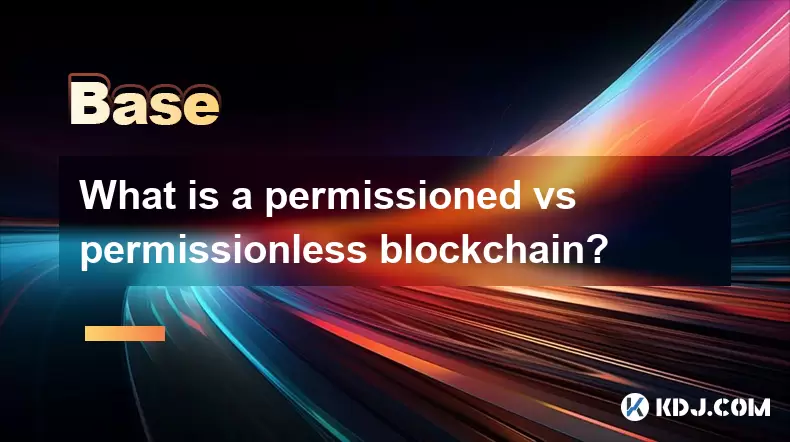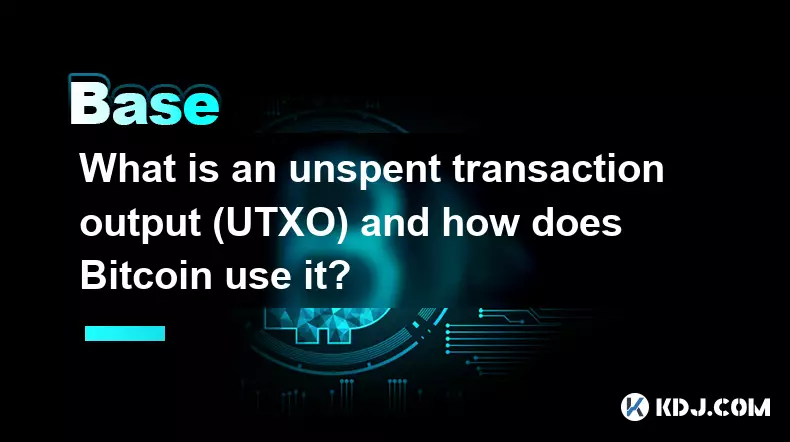-
 bitcoin
bitcoin $106680.127705 USD
0.67% -
 ethereum
ethereum $3615.722480 USD
-0.65% -
 tether
tether $0.999925 USD
-0.04% -
 xrp
xrp $2.550072 USD
5.91% -
 bnb
bnb $1002.572269 USD
-0.90% -
 solana
solana $168.746669 USD
1.08% -
 usd-coin
usd-coin $0.999832 USD
-0.03% -
 tron
tron $0.297244 USD
1.97% -
 dogecoin
dogecoin $0.182965 USD
0.71% -
 cardano
cardano $0.600432 USD
2.56% -
 hyperliquid
hyperliquid $41.439691 USD
-1.57% -
 chainlink
chainlink $16.548399 USD
2.40% -
 bitcoin-cash
bitcoin-cash $524.993680 USD
3.45% -
 stellar
stellar $0.302259 USD
4.10% -
 zcash
zcash $539.994871 USD
-16.31%
What is a permissioned vs permissionless blockchain?
Permissioned blockchains restrict access for enhanced privacy and control, while permissionless ones allow open participation, offering greater decentralization but slower transaction speeds.
Jul 05, 2025 at 07:34 pm

Understanding the Concept of Permissioned Blockchain
A permissioned blockchain refers to a type of distributed ledger technology where access to the network is restricted and controlled by a central authority or a pre-defined set of rules. Unlike open networks, only selected participants can join, validate transactions, or maintain the ledger.
In such systems, nodes must be granted permission before they can participate in consensus mechanisms. This model is commonly used in enterprise environments where privacy, scalability, and regulatory compliance are key priorities. Organizations like banks, supply chain managers, and healthcare providers often adopt this structure.
One notable feature of permissioned blockchains is that they offer faster transaction speeds compared to permissionless ones, mainly due to fewer validating nodes and streamlined consensus processes like Practical Byzantine Fault Tolerance (PBFT). However, this comes at the cost of decentralization and openness.
Exploring the Characteristics of Permissionless Blockchain
A permissionless blockchain allows anyone to join the network without needing prior authorization. These blockchains are fully decentralized, meaning no single entity controls the entire system. Bitcoin and Ethereum are two prominent examples of permissionless blockchains.
In these systems, anyone can become a validator or node, read the ledger, and submit transactions. The consensus mechanism typically relies on proof-of-work (PoW) or proof-of-stake (PoS), ensuring security through economic incentives rather than trust in specific entities.
Because of their open nature, permissionless blockchains are more transparent and resistant to censorship. They are ideal for applications requiring high levels of decentralization, such as DeFi platforms, NFT marketplaces, and public cryptocurrencies. However, they tend to have slower transaction times and higher energy consumption due to the need for broad consensus among many nodes.
Differences in Access Control Mechanisms
The most significant distinction between permissioned and permissionless blockchains lies in how access control is managed. In permissioned systems, access is tightly regulated, with predefined roles assigned to participants. Only approved users can perform certain actions like writing data or validating blocks.
- Participants must undergo identity verification
- Access rights are defined by administrators
- Transaction visibility may be limited to certain parties
Conversely, in permissionless blockchains, access control is minimal or non-existent. Any user can interact with the network anonymously, contributing to its decentralization but also increasing potential risks related to malicious behavior.
- No identity verification required
- All users have equal rights to participate
- Full transparency of transactions on the ledger
This divergence directly affects how each blockchain operates in terms of governance, security, and use cases.
Consensus Mechanism Variations
The way nodes reach agreement on the validity of transactions differs significantly between the two types of blockchains. In permissioned blockchains, since the number of validators is limited and known, consensus algorithms like PBFT or Raft are commonly used.
These mechanisms allow for faster decision-making and greater efficiency, especially when dealing with large volumes of transactions in a controlled environment. Because trust is partially established beforehand, there's less need for computationally expensive validation methods.
On the other hand, permissionless blockchains rely on resource-intensive consensus models such as PoW or PoS. These protocols ensure security through economic disincentives, making it costly for bad actors to manipulate the system.
- Proof-of-Work requires solving complex mathematical puzzles
- Proof-of-Stake depends on token holdings and staking commitments
- Both aim to prevent Sybil attacks and double-spending
The choice of consensus method has direct implications on scalability, energy consumption, and overall performance of the blockchain.
Use Cases and Industry Applications
Each type of blockchain serves distinct purposes depending on the needs of the organization or application. Permissioned blockchains are favored in industries where data privacy and regulatory compliance are crucial. For instance, financial institutions may use them to streamline interbank settlements or manage KYC records securely.
- Supply chain tracking with controlled access
- Private digital identity management
- Enterprise resource planning integration
Meanwhile, permissionless blockchains thrive in environments where decentralization and immutability are paramount. Publicly accessible ledgers support peer-to-peer transactions, smart contracts, and decentralized applications (dApps).
- Cryptocurrency transfers without intermediaries
- Decentralized finance (DeFi) platforms
- NFTs and digital collectibles
Selecting the appropriate blockchain type depends heavily on the intended use case, desired level of decentralization, and the trade-offs an organization is willing to accept.
Security Considerations in Both Models
Security strategies vary greatly between permissioned and permissionless blockchains. In permissioned systems, since the participants are known and vetted, the risk of malicious activity is inherently lower. Security focuses on protecting internal infrastructure and enforcing strict access policies.
However, this model introduces a single point of failure if the governing body is compromised. Therefore, organizations must implement robust encryption, multi-factor authentication, and regular audits to maintain integrity.
In contrast, permissionless blockchains derive their security from decentralization and cryptographic principles. The sheer number of nodes and the economic costs associated with launching an attack make these systems highly resilient.
- 51% attacks remain a theoretical threat
- Smart contract vulnerabilities require rigorous auditing
- Public key cryptography secures user identities and transactions
Despite their strengths, both models face unique challenges that must be addressed through continuous monitoring and proactive defense mechanisms.
Frequently Asked Questions
What determines whether a blockchain should be permissioned or permissionless?The decision depends on the use case, the level of decentralization needed, and regulatory requirements. If transparency and decentralization are critical, a permissionless model is preferred. For private, controlled environments, permissioned blockchains are more suitable.
Can a permissioned blockchain become permissionless over time?Technically, yes, but it would require a fundamental redesign of access controls, consensus mechanisms, and governance structures. Transitioning from one model to another is complex and rarely done in practice.
Are all public blockchains permissionless?Yes, by definition, public blockchains are open to anyone and thus fall under the permissionless category. Examples include Bitcoin, Ethereum, and Litecoin.
Do permissioned blockchains support smart contracts?Yes, many permissioned blockchains, such as Hyperledger Fabric and R3 Corda, do support smart contracts. However, execution and deployment may differ from those in permissionless environments due to access restrictions and governance models.
Disclaimer:info@kdj.com
The information provided is not trading advice. kdj.com does not assume any responsibility for any investments made based on the information provided in this article. Cryptocurrencies are highly volatile and it is highly recommended that you invest with caution after thorough research!
If you believe that the content used on this website infringes your copyright, please contact us immediately (info@kdj.com) and we will delete it promptly.
- SEI Price Prediction: Reversal Target in Sight? What the Charts Say
- 2025-11-12 05:10:01
- BlockDAG, Mantle, and Tron: Charting the Course for Crypto Dominance in 2025
- 2025-11-12 05:20:01
- BlockDAG, Dev Incentives, and Crypto Investment: A 2025 Perspective
- 2025-11-12 05:35:01
- Decoding XRP: From Crypto Chaos to Global Liquidity Standard?
- 2025-11-12 05:25:01
- Coinbase, BVNK, and Stablecoins: A New York Minute on Crypto's Next Big Moves
- 2025-11-12 04:35:02
- Polkadot Builder Party: Social Signals and DOT's Market Momentum
- 2025-11-12 05:40:01
Related knowledge

What is the difference between a transparent and a shielded transaction?
Nov 10,2025 at 05:59pm
Understanding Transparent Transactions in Cryptocurrency1. Transparent transactions are the standard form of transaction on most public blockchains li...

What is a "crypto airdrop farmer" and what strategies do they use?
Nov 09,2025 at 03:39pm
What Is a Crypto Airdrop Farmer?1. A crypto airdrop farmer is an individual who actively participates in blockchain projects to qualify for free token...

What is an unspent transaction output (UTXO) and how does Bitcoin use it?
Nov 12,2025 at 01:40am
Understanding the Concept of Unspent Transaction Output (UTXO)1. An Unspent Transaction Output, commonly referred to as UTXO, is a fundamental compone...

How does a crypto insurance protocol work?
Nov 08,2025 at 12:39am
Understanding Crypto Insurance Protocols1. A crypto insurance protocol operates by offering financial protection against losses incurred from digital ...

What is token composability and why is it called "DeFi Legos"?
Nov 09,2025 at 06:39am
Bitcoin's Role in Decentralized Finance1. Bitcoin remains the cornerstone of decentralized finance, serving as a benchmark for value and trustlessness...

What is an "exploit" versus a "hack" in the context of smart contracts?
Nov 09,2025 at 12:40am
Understanding Exploits in Smart Contracts1. An exploit refers to the utilization of a known vulnerability within a smart contract’s code to gain unint...

What is the difference between a transparent and a shielded transaction?
Nov 10,2025 at 05:59pm
Understanding Transparent Transactions in Cryptocurrency1. Transparent transactions are the standard form of transaction on most public blockchains li...

What is a "crypto airdrop farmer" and what strategies do they use?
Nov 09,2025 at 03:39pm
What Is a Crypto Airdrop Farmer?1. A crypto airdrop farmer is an individual who actively participates in blockchain projects to qualify for free token...

What is an unspent transaction output (UTXO) and how does Bitcoin use it?
Nov 12,2025 at 01:40am
Understanding the Concept of Unspent Transaction Output (UTXO)1. An Unspent Transaction Output, commonly referred to as UTXO, is a fundamental compone...

How does a crypto insurance protocol work?
Nov 08,2025 at 12:39am
Understanding Crypto Insurance Protocols1. A crypto insurance protocol operates by offering financial protection against losses incurred from digital ...

What is token composability and why is it called "DeFi Legos"?
Nov 09,2025 at 06:39am
Bitcoin's Role in Decentralized Finance1. Bitcoin remains the cornerstone of decentralized finance, serving as a benchmark for value and trustlessness...

What is an "exploit" versus a "hack" in the context of smart contracts?
Nov 09,2025 at 12:40am
Understanding Exploits in Smart Contracts1. An exploit refers to the utilization of a known vulnerability within a smart contract’s code to gain unint...
See all articles









































































